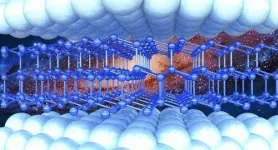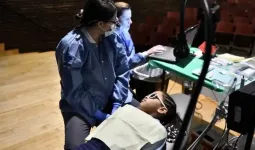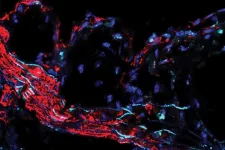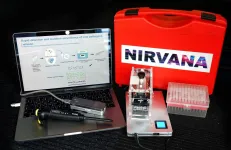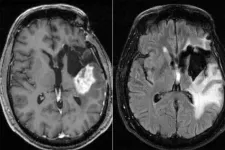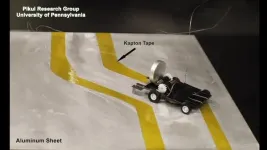INFORMATION:
Soft "sweat stickers" may streamline diagnosis of cystic fibrosis in children
2021-03-31
(Press-News.org) New "sweat stickers" may streamline the early diagnosis of cystic fibrosis by enabling scientists to easily gather and analyze sweat from the skin of infants and children. The stickers matched the performance of previous, more cumbersome devices when tested with 51 subjects, suggesting the stickers could address design obstacles that have held back the diagnosis and treatment of cystic fibrosis in pediatric patients. Diagnosing cystic fibrosis in infancy or childhood is critical to achieve good outcomes, as current treatments must be given early to extend lifespans and alter the course of the disease. Many current diagnostics work by detecting levels of chloride in sweat, which are elevated in cystic fibrosis patients. However, these tests must often be repeated and use unwieldy wrist-wrapped devices, making them impractical for infants with soft skin and low levels of sweat. To address this need, Tyler Ray and colleagues developed their sweat stickers, which are soft microfluidic devices with a multilayered design that can conform to the skin of both infants and adults. The stickers rapidly collect and store sweat from the skin, which scientists can then analyze using a smartphone application. The stickers collected sweat as effectively as a traditional method named MSCS in a pilot study with 18 healthy subjects and 33 patients ranging from 2 months to 51 years old. Unlike MSCS, the stickers gathered enough sweat to avoid any repeated tests and did not cause uncomfortable skin indentations in infants. The researchers call for larger studies to further establish their platform's accuracy and precision.
ELSE PRESS RELEASES FROM THIS DATE:
Mothers bear the cost of the pandemic shift to remote work
2021-03-31
For many parents, the COVID-19 pandemic has made life's everyday juggling act--managing work, school, extracurricular, and household responsibilities--much, much harder. And according to a new study led by Penn sociologists, those extra burdens have fallen disproportionately on mothers.
The research, shared in the April issue of the journal Gender and Society, investigated how shifts in work and school that arose due to the pandemic triggered changes in the division of labor in families. Using data on two-parent households from a nationwide survey conducted in April 2020, the researchers found that ...
A Skoltech method helps model the behavior of 2D materials under pressure
2021-03-31
Scientists from the Skoltech Center for Energy Science and Technology (CEST) have developed a method for modeling the behavior of 2D materials under pressure. The research will help create pressure sensors based on silicene or other 2D materials. The paper was published in the ACS Nano journal.
Silicene, which is regarded as the silicon analog of graphene, is a two-dimensional allotrope of silicon. In its normal state, bulk silicon is a semiconductor with a diamond crystal type structure. As it thins down to one or several layers, its properties change dramatically. However, it has not yet been possible to study the change in the electronic properties of 2D materials at high pressure.
Scientists from Russia, Italy, the United ...
New study supports the effectiveness of the ForsythKids school-based dental program for reducing untreated tooth decay
2021-03-31
In a longitudinal study published earlier this month in the Journal of the American Dental Association, researchers analyzed untreated decay in a cohort of nearly 7,000 children enrolled in the ForsythKids preventive dentistry program. Over the course of six years, the percentage of children with untreated cavities in the program decreased from 39 to 19 percent, suggesting that school-based prevention programs are effective in combating childhood dental disease.
Tooth decay is the most common chronic early childhood disease in the United States. More than half of children aged 6-8 years old have had a cavity, and kids from low-income families ...
Scientists find genetic link to clogged arteries
2021-03-31
High cholesterol is the most commonly understood cause of atherosclerosis, a hardening of the arteries that raises the risk of heart attack and stroke. But now, scientists at Washington University School of Medicine in St. Louis have identified a gene that likely plays a causal role in coronary artery disease independent of cholesterol levels. The gene also likely has roles in related cardiovascular diseases, including high blood pressure and diabetes.
The study appears March 24 in the journal Science Translational Medicine.
Studying mice and genetic data from people, the researchers found ...
Fast, portable test can diagnose COVID-19 and track variants
2021-03-31
LA JOLLA--(March 31, 2021) Clinicians using a new viral screening test can not only diagnose COVID-19 in a matter of minutes with a portable, pocket-sized machine, but can also simultaneously test for other viruses--like influenza--that might be mistaken for the coronavirus. At the same time, they can sequence the virus, providing valuable information on the spread of COVID-19 mutations and variants. The new test, dubbed NIRVANA, was described online today by a multi-institution team of scientists in the journal Med.
"This is a virus detection and surveillance method that doesn't require an expensive infrastructure like other approaches," says Juan Carlos Izpisua Belmonte, co-corresponding author and a professor in Salk's Gene Expression ...
OCD patients with comorbidities respond well to deep brain stimulation
2021-03-31
AURORA, Colo. (March 31, 2021) - A new study published in Frontiers in Psychiatry finds that patients with Obsessive Compulsive Disorder (OCD) as well as other psychiatric comorbidities, such as autism spectrum or tic disorders, may respond well to Deep Brain Stimulation (DBS).
DBS is a minimally invasive neurosurgical procedure that uses coordinates to target certain areas of the brain, implanting electrodes that can help regulate abnormal brain activity. DBS procedures are rare for OCD in the United States; only a couple hundred patients have received this treatment for OCD management since its FDA approval ...
Chemo for glioblastoma may work better in morning than evening
2021-03-31
An aggressive type of brain cancer, glioblastoma has no cure. Patients survive an average of 15 months after diagnosis, with fewer than 10% of patients surviving longer than five years. While researchers are investigating potential new therapies via ongoing clinical trials, a new study from Washington University in St. Louis suggests that a minor adjustment to the current standard treatment -- giving chemotherapy in the morning rather than the evening -- could add a few months to patients' survival.
The study appears online in the journal Neuro-Oncology Advances.
Average overall survival ...
Nursing graduate students report high levels of stress, anxiety, depression
2021-03-31
AURORA, Colo. (March 30, 2021 - Researchers at the University of Colorado College of Nursing have found that nearly one-quarter of graduate nursing students have reported elevated levels of stress, anxiety and depression, compounded in the past year by the COVID-19 pandemic.
Study findings, published recently in END ...
Low-cost solar-powered water filter removes lead, other contaminants
2021-03-31
A new invention that uses sunlight to drive water purification could help solve the problem of providing clean water off the grid.
The device resembles a large sponge that soaks up water but leaves contaminants - like lead, oil and pathogens - behind. To collect the purified water from the sponge, one simply places it in sunlight. The researchers described the device in a paper published this week in the journal Advanced Materials.
The inspiration for the device came from the pufferfish, a species that takes in water to swell its body when threatened, and then releases water when danger passes, said the device's co-inventor END ...
Even without a brain, Penn Engineering's metal-eating robots can search for food
2021-03-31
When it comes to powering mobile robots, batteries present a problematic paradox: the more energy they contain, the more they weigh, and thus the more energy the robot needs to move. Energy harvesters, like solar panels, might work for some applications, but they don't deliver power quickly or consistently enough for sustained travel.
James Pikul, assistant professor in Penn Engineering's Department of Mechanical Engineering and Applied Mechanics, is developing robot-powering technology that has the best of both worlds. His environmentally controlled voltage source, or ECVS, works like a battery, in that the energy is produced by repeatedly breaking ...
